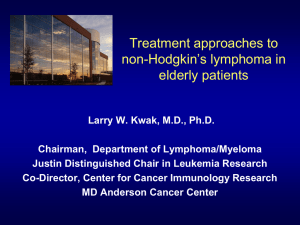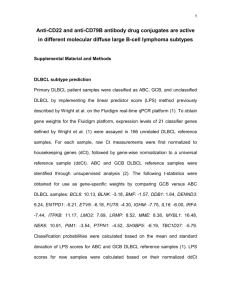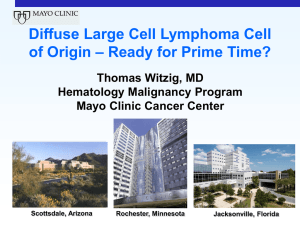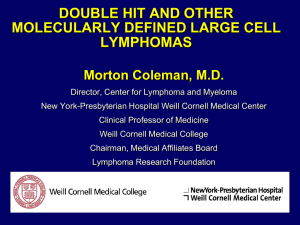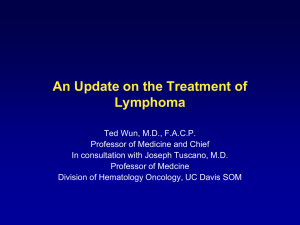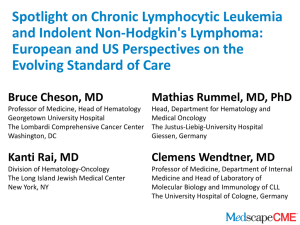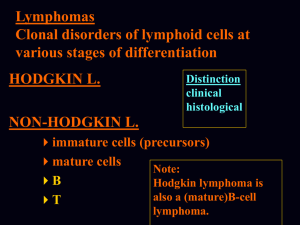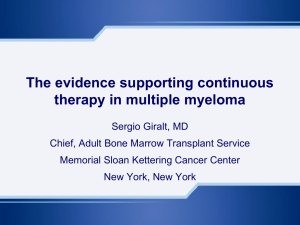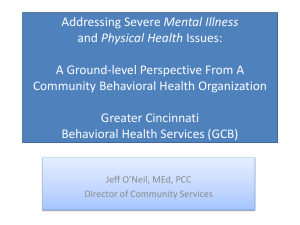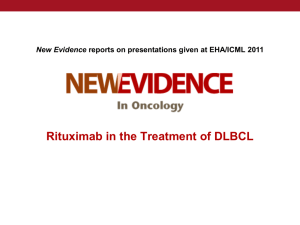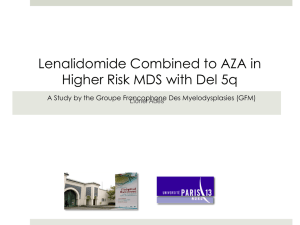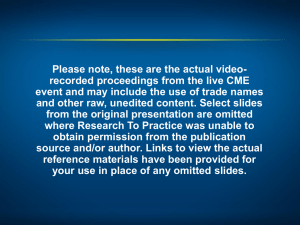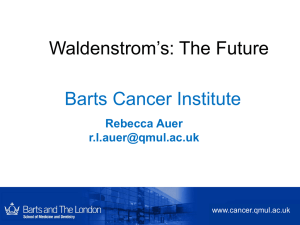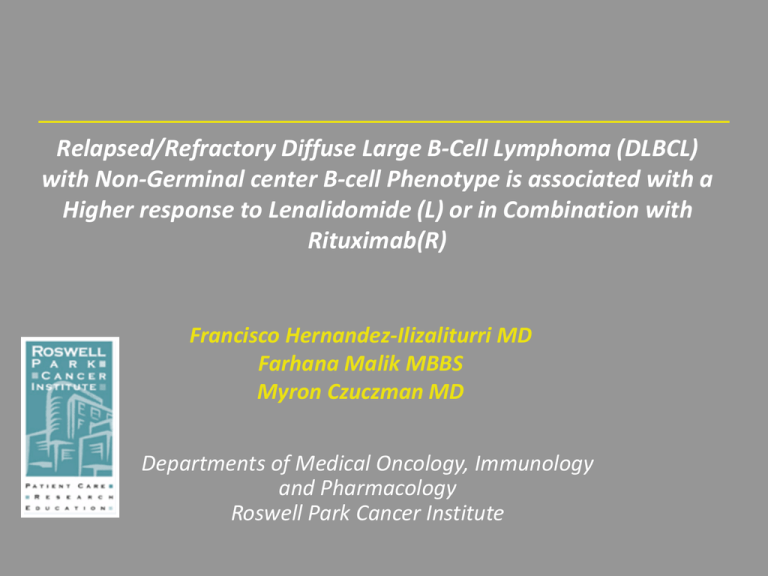
Relapsed/Refractory Diffuse Large B-Cell Lymphoma (DLBCL)
with Non-Germinal center B-cell Phenotype is associated with a
Higher response to Lenalidomide (L) or in Combination with
Rituximab(R)
Francisco Hernandez-Ilizaliturri MD
Farhana Malik MBBS
Myron Czuczman MD
Departments of Medical Oncology, Immunology
and Pharmacology
Roswell Park Cancer Institute
Classification of Newly Diagnosed Diffuse Large B-Cell
Lymphoma (DLBCL) According to the Hans Criteria Defines
Two Groups of Patients with Different Clinical Outcomes
Following Systemic Rituximab-Multi Agent Anthracycline-Based
Therapy
Evolution in the management of aggressive B-cell
lymphomas
Diffuse large B-cell lymphoma (DLBCL) is the most common type
of lymphoma diagnosed in the Western Hemisphere
Patients with DLBCL exhibit a heterogeneous clinical behavior and
prognosis
Several biomarkers that predict the clinical outcome of DLBCL
patients had been identified and validated (i.e. Bcl-2 expression, IPI
score or gene profiling studies)
The addition of rituximab to systemic chemotherapy has improved
the clinical outcome of DLBCL patients, challenging previously
established biomarkers of response
Distinct types of DLBCL identified by gene expression
profiling
Rosenwald et Al, NEJM 2002; 346:1937-47
Studies included patients with DLBCL
treated with CHOP or CHOP-like
chemotherapy prior to rituximab
Alizadeth A, et al. Nature 2000; 403:503 - 511
Algorithm for Subtype classification of
DLBCL
GCB
GCB
+
MUM1
CD10
-
+
+
Bcl-6
-
Non-GCB
Non-GCB
The concordance rate of the Han’s Algorithm to
gene profiling studies is 80%
Hans et al, Blood 2004, 103: 275-282
Differences in outcomes among patients
with DLBCL treated with R+CHOP
subdivided by IHC
Author
Vose J et al.
(JCO 2008; 26:45874594)
Patients(n)
N = 243
Patient population
DLBCL treated with
R+CHOP(131) vs.
CHOP (112)
Ilie I et al.
(Int J Hem 2009;
90:74-80)
N=92
DLBCL treated with
R+CHOP(37) or CHOPlike chemotherapy
PFS or similar
EFS, R-CHOP GCB = 67% vs.
Non-GCB = 52% (P = NS) at 3
yrs
EFS, R-CHOP
GCB = 52% vs. non-GCB =
58% (P = NS)
at 3 yrs.
DLBCL treated with
FFS for R+CHOP GCB = 68%
R+CHOP(90) vs. CHOP vs. non GCB 63% (P=NS) at
(104)
27 months
DLBCL treated with
GCB = 70% vs. non-GCB = 75
R+CHOP like
(P = NS) at 37 months
OS
R-CHOP (131)
GCB = 85% vs.
Non-GCB = 69%
(P =0.032) at 3yrs
R-CHOP (n=37)
GCB = 58% vs. non-GCB =
69% (P = NS) at 3yrs
Criteria
Hans
Hans
Nyman H et al
N=194
R-CHOP
Hans
Blood 2007;
(90) GCB = 77% vs. non-GCB
109:4930-4935)
76% (NS) at 27 months
Nyman H et al
N=88
GCB = 76% vs. non-GCB =
Hans
Mod Pathology
77% (P = NS) at 37 months
2009; 22:1-8
Choi W et al
N=170
DLBCL treated with
R-CHOP (67)GCB = 81% vs.
R-CHOP (67) GCB = 92% vs.
Modified
Clin Cancer Res
R+CHOP like (67) or
non-GCB = 36 (P = 0.006) at 3 non-GCB = 44% (P < 0.001)
Hans
2009; 15:5494-5502
CHOP (103)
yrs
at 3 yrs
DLBCL = diffuse large B-cell lymphoma; GCB = germinal center B-like; non-GCB = non-germinal center B-like; DLBCL = diffuse large Bcell lymphoma; R+CHOP = rituximab, cyclophosphamide, doxorubicin, vincristine and prednisone; OS = Overall survival; PFS =
progression free survival; EFS = event free survival; FFS = failure free survival.
To study clinical differences between GCB- and nonGCB DLBCL treated at RPCI
Retrospective study of 191 patients DLBCL treated at our Institution
between 2000 and 2007 with the following characteristics
– Previously untreated DLBCL
– Patients that received front line therapy with rituximab in
combination with CHOP or DA-EPOCH
– Tumor specimen available for immunohistochemistry (IHC) studies
•
CD20, CD10, BCL2, BCL6 and MUM1
– Patients were excluded from the analysis if any of the following:
•
•
•
Incomplete clinical data
Transformed lymphoma and primary CNS DLBCL
HIV related DLBCL
Demographic, clinical and pharmacological (i.e. cumulative doses of
rituximab, chemotherapy and growth factor support) were included
in the analysis
Patients were classified as GCB- or non-GCB DLBCL using
the Hans algorithm (Hans et al, Blood 2004, 103: 275-282)
Differences in end-point studies were evaluated between
GCB- and non-GCB patients
Repsonse rate
Cumulative chemoimmunotherapy doses received
Overall survival (OS)
Progression free survival (PFS)
Demographics
Median Age
Age
< 60
> 60
Sex
F
M
Race
Caucasian
Other
Diagnosis
DLBCL
Composite/Transformed
Stage
I
II
III
IV
Bulky
Extra-nodal disease
ECOG Performance status
<2
>2
IPI score
0
1
2
3
4
5
IPI risk category
Low
Low Intermediate
High Intermediate
High
All patients (n = 191)
61 yrs (19-87)
GCB-DLBCL(n = 57)
59 yrs (23-86)
Non-GCB DLBCL(n = 55)
59 yrs (27-85)
Unknown status DLBCL(n=79)
61 yrs (19-87)
90 (47.1%)
101(52.9%)
29 (50.9%)
28 (49.1%)
25 (45.5%)
30 (54.5%)
36 (45.6%)
43 (54.4%)
72(37.7%)
119(62.3%)
24(42.1%)
33(57.9%)
23(41.8%)
32(58.2%)
25(31.6%)
54(68.4%)
177(92.7%)
14(7.3%)
53(93%)
4(6%)
53(96.4%)
2(3.6%)
71(89.9%)
8(10.1%)
188(97.9%)
3(2.1%)
57(100%)
0
54(98.2%)
1(1.8%)
77(97.5%)
2(2.5%)
39(20.4%)
26(13.6%)
59(30.9%)
67(35.1%)
38(19.9%)
137(71.7%)
8(14.1%)
9(15.8%)
19(33.3%)
21(36.8%)
11(19.3%)
43(75.4%)
14(25.5%)
7(12.7%)
17(30.9%)
17(30.9%)
11(20%)
34(61%)
17(21.5%)
10(12.7%)
23(29.1%)
29(36.7%)
16(20.3%)
60(75.9%)
158(82.75%)
33(17.3%)
45(78.9%)
12(21.1%)
44 (80%)
11 (20%)
69(87.3%)
10(12.7%)
19(9.9%)
45(23.6%)
69(36.2%)
42(21.9%)
14(7.3%)
2(1.1%)
6(10.5%)
11(19.3%)
18(31.6%)
15(26.3%)
7(12.3%)
0(0)
5(9.1%)
13(23.7%)
23(41.8%)
11(20%)
2(3.6%)
1(1.8%)
8(10.1%)
21(26.7%)
28(35.4%)
16(20.2%)
5(6.3%)
1(1.3%)
65(34.1%)
70(36.6%)
40(20.9%)
16(8.4%)
17(29.8%)
19(33.3%)
14(24.6%)
7(12.3%)
18(32.7%)
23(41.8%)
11(20%)
3(5.5%)
30(37.9%)
28(35.6%)
15(18.9%)
6((7.6%)
Treatment and Outcomes
Treatment
R+CHOP
R+ DA-EPOCH
All patients (n = 191)
GCB-DLBCL
Non-GCB DLBCL
Unknown status DLBCL
169 (88%)
22 (12%)
47 (82.5%)
10 (17.5%)
51 (90.9%)
4 (9.01%)
71 (89.9%)
8 (10.1%)
Median number of cycles
5.49 (1-8)
5.74 (1-8)
5.35 (1-8)
5.4 (1-8)
Treatment delays
39 (20.4%)
16 (28.1%)
9 (16.4%)
14 (17.7%)
Median dose of agent (mg/m2)
Rituximab
4,020 +/- 1,788 ste
4,116 +/- 1,936 ste 3,804 +/- 1,774 ste 3,947 +/- 1,652 ste
Cyclophosphamide
8,077 +/- 3,209 ste
8,205 +/- 3,095 ste 7,614 +/- 3,520 ste 8,694 +/- 3,098 ste
Vincristine
12 +/-3.95 ste
12 +/- 3.5 ste
10.4 +/- 4.2 ste
12 +/- 4.1 ste
Doxorubicin
468.5 +/- 219 ste
452 +/- 214 ste
463 +/- 218 ste
498 +/- 227
Response rate (%)
ORR
170 (89%)
53 (93%)
49 (89.1%)
68 (86.1%)
CR
156 (81.7%)
48 (84.2%)
43 (78.2%)
65 (82.3%)
PR
14 (7.3%)
5 (8.8%)
6 (10.9%)
3 (3.8%)
PD or SD
12 (6.2%)
4 (7.1%)
4 (7.3%)
4 (5.1%)
Unknown
9 (4.8%)
0
2 (3.6%)
7 (8.9%)
Radiation in front-line
47 (24.6%)
10 (17.5%)
13 (23.6%)
24 (30.4%)
BMT
12 (6.3%)
3 (5.3%)
7 (12.7%)
2 (2.5%)
GCB = germinal center B-like; non-GCB = non-germinal center B-like; DLBCL = diffuse large B-cell lymphoma; R+CHOP =
rituximab, cyclophosphamide, doxorubicin, vincristine and prednisone; R+DA-EPOCH = rituximab plus dose adjested etoposide,
cyclophosphamide, doxorubicin, vincristine and prednisone. CR = complete response, PR = partial response, PD = progressive
disease, SD = stable disease. BMT = bone marrow transplant.
DLBCL with a non-GCB phenotype by IHC had an
inferior PFS following R-CHOP-21 than GCB-DLBCL
GCB DLBCL
Log Rank P =
0.017
Non-GCB
DLBCL
Mean Progression Free Survival (months)
95% Confidence Interval
Estimate Std. Error Lower Bound Upper Bound
GCB
68.9
4.7
59.7
78.1
Non-GCB
75.1
9.5
56.4
93.7
Overall
87.9
6.7
74.9
101.1
The median survival for non-GCB DLBCL was 45.1 months, whereas the
median survival for patients with GCB-DLBCL has not be reach.
DLBCL with a non-GCB phenotype by IHC had an
inferior overall survival following R-CHOP-21 than
GCB-DLBCL
P = 0.037
GCB DLBCL
Non-GCB
DLBCL
Mean (months)
95% Confidence Interval
Estimate Std. Error Lower Bound Upper Bound
GCB
75.5
4.1
67.5
83.6
Non-GCB
58.5
4.5
49.6
67.3
Overall
69.7
3.3
63.1
76.2
The median survival for non-GCB DLBCL was 75.4 months, whereas the
median survival for patients with GCB-DLBCL has not be reach.
In summary
Our data suggest that the Hans algorithm can predict
clinical outcomes of patients with DLBCL undergoing
frontline chemo-immunotherapy
Patients with Non-GCB DLBCL while having a comparable
initial overall response rate (CR and PR) to R+CHOP had a
shorter PFS and OS than GCB-DLBCL
Non-GCB DLBCL represent a subgroup of DLBCL for which
innovative therapeutic strategies targeting key regulatory
pathways in the induction and/or maintenance setting are
need in an attempt to improve their PFS and OS
CALGB 50303 Phase III Randomized Study of
R-CHOP vs. Dose-Adjusted EPOCH-R with
Molecular Profiling in Untreated De Novo
Diffuse Large B-Cell Lymphomas
R+CHOP x 6
De Novo
CD20+
DLBCL
stage II,III or
IV
Tumor
Biopsy
for GEP
studies
Randomization
R-DA-EPOCH
x6
Lenalidomide in diffuse large B-cell
lymphoma (DLBCL): correlating response
with tumor characteristcs
Thalidomide analogues: immune-mediated
inflammatory disease (IMiDs) in B-cell lymphomas
O
Thalidomide/IMiDs target MM cells in the bone marrow (BM) microenviroment
O
H
N
C. Thalidomide/IMiD
O
N
MM cells
O
Thalidomide
O
O
IL-6
TNFa
IL-1b BM stromal
cells
B. Thalidomide/IMiD
A. Thalidomide/IMiD
H
N
N
ICAM-1
O
BM vessels
NH
2
VEGF
bFGF
CC-5013 (Revimid)
PBMC
O
O
H
N
N
NH 2
O
CC-4047 (Actimid)
D. Thalidomide/IMiD
O
CD8+ T cells
NK cells
IL-2
IFN
E. Thalidomide/IMiD
MM = multiple myeloma; VEGF = vascular endothelial growth factor
PBMC = peripheral-blood mononuclear cells; NK = natural killer
TNF = tumour necrosis factor
Davies FE, et al. Blood, 2001;98:210–6
Hayashi T, et al. Blood 2002;100:314b (Abstract 4800)
Are Highly
Expressed
in
NF-kBNF-kB
targetTarget
genesGenes
are highly
expressed
in activated
B
Activated
B Cell-like
Diffuse
Large
B Cell
Lymphoma
cell-like
diffuse
large
B-cell
lymphoma
NF-kB
target
gene
Lymphoma biopsy samples
Courtesy of L. Staudt
IMiDs in vitro decrease NFB activity and arrest
DNA synthesis in NHL cells
CC5013
Raji cells
400,000
CPU 48 hours
Raji cells
30,000
300,000
200,000
100,000
0
0
20,000
2.5
5
10
µg/mL
20
40
20
40
CC4047
400,000
10,000
0
CPU 48 hours
Raji cells
Relative light units
40,000
300,000
200,000
100,000
0
0
2.5
5
10
µg/mL
Hernandez-Ilizaliturri FJ, et al. Clin Can Res 2005;11:5984–92
Stromal-1 signature encodes extracellular matrix components and
macrophage/myeloid restricted proteins (favourable)
The stromal-2 signature encodes regulators and components
of angiogenesis (unfavourable)
Tumor micro vessel density decreases after
treatment with lenalidomide
Placebo CD31 staining
Lenalidomide CD31 staining
Raji xenografts
Actimid CD31 staining
MVD (vessels/llpf)
125
Bars show means
Error bars show mean ± 1.0 SE
100
†
75
*
50
25
0
*p=0.009
†p=0.005
*†
Placebo
Lenalidomide
Actimid
Reddy N, et. al. Br J Haematol 2007, 140:36-45
Lenalidomide induces CRs and PRs in patients with relapsed and treatmentrefractory CLL
Plasma levels of TNF-, soluble TNF receptor 1 (TNF-R1), interferon (IFN)-, VEGF,
bFGF, interleukin (IL)-1β, -2, -6, -8, -10, -12, IL-1 receptor antagonist (IL-1RA), and
soluble IL-2 receptor (IL-2R) were measured at different time intervals pre and
post-treatment
A significant reduction in plasma VEGF level was observed on day 28 in four
patients that achieved a response (mean reduction of 55.6pg/mL [± 15.3],
p=0.036) and on day 90 in four patients with SD or clinical improvement (mean
reduction of 50.9pg/mL [± 3.3], p=0.003).
Ferrajoli A, et al. Blood 2006;108:94a (Abstract 305)
*
20
INF-
15
*p=0.014
†p=0.004
†
10
5
*†
0
pg/mL
DMSO Lenalidomide Actimid
700
600
500
400
300
200
100
0
TNF-a
*p=0.013
†p=0.024
†
*
pg/mL
pg/mL
Cytokine secretion by DC after in-vitro
exposure to lenalidomide
4,000
MCP-1
3,000
*p<0.001
†p=0.001
*
†
2,000
1,000
*†
0
DMSO Lenalidomide Actimid
*†
DMSO Lenalidomide Actimid
Reddy N, et. al. Br J Haematol 2007, 140:36-45
Differences in the number and pattern of NK cells
infiltrating the tumour bed of
lymphoma-bearing SCID mice treated with IMiDs
Raji xenografts
Tumour infiltrated with NK-cells (%)
Bars show means
Error bars show mean ± 1.0 SE
60
Placebo-treated infiltration of NK-cells
(CD49b+) in the periphery of the tumour
*
†
40
*†
Lenalidomide-treated infiltration of
NK-cells (CD49b+) within the tumour
20
0
Placebo
*p=0.012
†p=0.015
Lenalidomide
Actimid
Reddy N, et. al. Br J Haematol 2007, 140:36-45
IMiD enhancement of rituximab-dependent ADCC ex
vivo is mediated via co-stimulation
of NK-cells by DCs
Co-stimulation with DCs
Raji
Specific lysis (%)
p<0.007
Bars show means
20
30
DMSO
Lenalidomide
Pomalidomide
Error bars show mean
± 1.0 SE
10
0
Specific lysis (%)
30
Without co-stimulation with DCs
Raji
DMSO
Lenalidomide
Pomalidomide
Bars show means
20
Error bars show mean
± 1.0 SE
10
0
Rituximab
Isotype
Splenocytes
Rituximab
Isotype
PBMC
Reddy N, et. al. Br J Haematol 2007, 140:36-45
Pomalidomide in combination with rituximab
improves survival in lymphoma-bearing severe
combined immunodeficiency (SCID) mice
1.2
Mice/group
(n=15)
Cumulative survival
1.0
95% CI
21
20–22
Rituximab
38
26–50
Pomalidomide
21
21–21
Pomalidomide
+ rituximab
74
70–78
Pomalidomide* + rituximab Placebo
0.8
0.6
0.4
Pomalidomide
0.2
0
Median survival
(days)
Rituximab*
Placebo
0
20
40
60
80
100
120
Time to development of limb paralysis (days)
*p=0.0012
CI = confidence interval
Hernandez-Ilizaliturri FJ, et al. Clin Can Res 2005;11:5984–92
Lenalidomide in combination with rituximab improves
survival in lymphoma-bearing SCID mice
1.2
Mice/group
(n=15)
Median survival
(days)
95% CI
Placebo
21
18–24
0.6
Rituximab
45
32–58
0.4
Lenalidomide
21
20–22
Lenalidomide +
rituximab
58
43–73
Cumulative survival
1.0
0.8
Lenalidomide* + rituximab
0.2
Lenalidomide
Placebo
0
0
20
40
Rituximab*
60
80
100
120
Time to development of limb paralysis (days)
*p=0.167
Hernandez-Ilizaliturri FJ, et al. Clin Can Res 2005;11:5984–92
Lenalidomide Monotherapy in Relapsed or Refractory
Aggressive Non-Hodgkin’s Lymphoma: NHL-002
Patients self-administered oral lenalidomide (25 mg once daily) on days 1 to 21 of every 28-day
cycle. Patients continued therapy for 52 weeks as tolerated or until disease progression.
Histology
No. of Patients
CR CRu PR SD PD ORR (%)
Aggressive NHL
49
2
4
11
11
21
35
Diffuse large B-cell lymphoma
26
1
2
2
7
14
19
Follicular center lymphoma, grade 3
5
0
1
2
0
2
60
Mantle-cell lymphoma
15
1
1
6
2
5
53
Transformed low-grade lymphoma
3
0
0
1
2
0
33
O
N
NH 2
O
H
N
O
Wiernik P, et al. Journal of Clinical Oncology, 26; 2008: 4952-4957
Lenalidomide Monotherapy in Relapsed or Refractory
Aggressive Non-Hodgkin’s Lymphoma
The estimated median duration
of response was 6.2 months
(range, 0 to 12.8 months), and
median PFS was 4.0 months
(range, 0 to 14.5 months).
Wiernik P, et al. Journal of Clinical Oncology, 26; 2008: 4952-4957
Confirmation of the Efficacy and Safety of Lenalidomide Oral
Monotherapy in Patients with Relapsed or Refractory Diffuse LargeB-Cell Lymphoma: Results of An International Study (NHL-003)
NHL-003 evaluated the efficacy of single-agent lenalidomide in patients
with relapsed/refractory aggressive NHL that had received at least one prior
treatment and had measurable disease (Median 3, range 1-6)
Lenalidomide was administered at 25mg/day p.o. on days 1–21 of a 4-week
cycle until disease progression or unacceptable toxicity
Results in patients with DLBCL (N=73) demonstrated:
The overall response rate to lenalidomide was 29% (21/73)
While some complete response were observed (4%, 3/73), most of the patients
achieved a partial remission (25%, 18/73).
Eleven patients (15%) had stable disease
The most common grade 3 or 4 adverse events were neutropenia (32%),
thrombocytopenia (15%), asthenia (8%) and anemia (7%).
Czuczman M, et al. Blood (ASH Annual Meeting Abstracts) 2008 112: 268a
Algorithm for Subtype Differentiation
GCB
GCB
+
MUM1
CD10
-
+
+
Bcl-6
-
Non-GCB
Non-GCB
Iqbal J et al. Leukemia 2007, 1–12
Hans et al, Blood 2004, 103: 275-282
Can we predict clinical response to
Lenalidomide in DLBCL patients?
Retrospective study of patients with DLBCL treated with
lenalidomide at Roswell Park Cancer Institute (RPCI)
Patients were divided into two cohorts using the criteria
proposed by Hans et al and Igbal et al :
– Germinal center B-cell-like (GCB)
– Non-GCB
Tumor biopsies are routinely stained for MUM1, CD10, Bcl-6
and Ki67 by the Pathology Department at RPCI
Responses to lenalidomide were assessed by standard and/or
revised Cheson criteria
Differences in response rate, duration of response to
lenalidomide and overall survival were analyzed using the
software program SPSS 14
Can we predict clinical response to
Lenalidomide in DLBCL patients?
Sample size 19, 11F/8M
Histological Diagnosis:
– DLBCL = 13
– FL and DLBCL (Composite) = 5
– Transformed NHL = 1
IHC classification of the patients:
– Non-GCB = 9
– GBC = 9
– Unknown = 1 (Bcl-6 positive, T-cell rich DLBCL)
Median Age 64 (43 to 89)
Median number of prior therapies = 4 (2 – 13)
Median cycles of lenalidomide = 3 (1 – 20)
Differences in response rate between Non-GCB
and GCB-like DLBCL to lenalidomide
*
*P = 0.011
*
Median number of prior treatment: Non-GCB = 4.88 (+/- 1.03) vs. GCB = 4.33 (+/- 0.64),
Chi square P = 0.46
No differences in IPI score, histology, stage or other demographic characteristics were
seen at time of lenalidomide Rx between the two groups
Response to lenalidomide single agents in patients with DLBCL
All Patients (n = 18)
Median number of lenalidomide
cycles
GCB-phenotype
(N=9)
Non GCB-phenotype
(N=9)
3.5 (1-24)
2 (1-21)
Responses as per revised Cheson
criteria (PET scan included):
Complete response (CR)
Partial response (PR)
Stable disease (SD)
Progression of disease (PD)
Overall response (CR + PR)
5 (27.7%)
3 (16.6%)
1 (5.5%)
9 (50%)
8 (44.4%)
1 (11.1%)
0 (0%)
1 (11.1%)
7 (77.7%)
1 (11.1%)*
4 (44.4%)
3 (33.3%)
0 (0%)
2 (22.2%)
7 (77.7%)* P=0.011
Responses as per 1999 Cheson
criteria (PET scan excluded):
Complete response (CR)
Partial response (PR)
Stable disease (SD)
Progression of disease (PD)
Overall response (CR + PR)
4 (22.2%)
3 (16.6%)
2 (11.1%)
9 (50%)
7 (38.8%)
1 (11.1%)
0 (0%)
1 (11.1%)
7 (77.7%)
1 (11.1%)*
3 (44.4%)
3 (33.3%)
1 (11.1%)
2 (22.2%)
6 (66.6%)*P=0.048
Deaths (number, %)
9 (50%)
5 (55.5%)
4 (44.4%)
PFS (median, months)
4.9 (1.4 to 8.6)
2.4 (0.3-4.45)*
DLBCL = diffuse large B-cell lymphoma, PET = positron electron tomography
7 (1-24)
11.2 (3.9 to 18.5)*
*P=0.008
Progression free survival following Lenalidomide
therapy in DLBCL according to histological subtype
DLBCL Type
Mean (Days)
Estimate
Std. Error
95% Confidence Interval
Lower Bound
Upper
Bound
Non-GCB
417.278
82.838
254.914
579.641
GCB
130.889
62.125
9.124
252.654
Overall
281.767
63.811
156.697
406.836
Progression free survival following Lenalidomide
therapy in pure DLBCL
DLBCL Subtype
Mean
Estimate
Non-GCB
GCB
Overall
Std.
Error
95% Confidence Interval
Lower
Bound
Upper
Bound
421.048
96.152
232.589
609.506
162.600
108.83
7
.000
375.921
321.271
83.328
157.947
484.594
DLBCL with a non-GCB phenotype by IHC had a better
overall survival following lenalidomide
Response rate in DLBCL with a non-GCB phenotype by
IHC treated with rituximab and lenalidomide
Patients with refractory/relapsed NHL treated at University of Bologna with
rituximab in combination with lenalidomide (mean number of cycles =4)
Tissue array submitted to RPCI for MUM-1, Bcl-6, and CD10 IHC
Histological Diagnosis (revised and re-classified at RPCI):
– DLBCL = 10
– FL3a/b = 3
– Transformed NHL = 1
IHC classification of the patients by the Hans algorithm was feasible in 10pts:
– Non-GCB = 8
– GBC = 0
– Other (FL) = 2
ORR for all cases submitted = 50% (7/14)
ORR for Non-GCB = 50% (4/8)
In summary
Lenalidomide monotherapy or in combination with rituximab
are active salvage therapies in relapsed/refractory DLBCL
Our data strongly suggest that two previously identified groups
of patients with DLBCL (GCB vs. non-GCB) appear to have
dramatically different degrees of responsiveness to
lenalidomide
with or without rituximab in the
relapsed/refractory setting
Tumor specimens from patients treated at two additional
institutions (i.e. Mayo Clinic and the John Theurer Cancer
Center at Hackensack University Medical Center) are currently
being evaluated and classified in order to further validate our
findings
Differential efficacy of bortezomib plus chemotherapy
within molecular subtypes of diffuse large B-cell lymphoma
Gene expression
profiling (GEP)
Relapsed/Refractory
DLBCL (N=49)
Biopsy
Immunohistochemistry (IHC)
CD10
Bcl-6
Proceed to Part B if
clinically indicated
Part A Bortezomib
(N=23)
Treat until disease progression
or maximum allowable cycles
Part B Bortezomib + DA-EPOCH
(N=44)
MUM1
ABC DLBCL
(N=5)
GCB DLBCL
(N=10)
ABC DLBCL
(N=12)
GCB DLBCL
(N=12)
DLBCL subtype classification by
GEP or IHC
ABC DLBCL
(N=12)
GCB DLBCL
(N=15)
Treat until disease progression
or maximum allowable cycles
Dunleavy et al. Blood. 2009; 113:6069-76
Overall study schema for proposed Phase III
registrational trial of lenalidomide in r/r DLBCL
Lenalidomide
N=25
Non-GCB
Relapse
Refractory
DLBCL
Lenalidomide
N=74
Non-GCB
Stratify by
IHC
subtyping
Control
N=25
Control
N=74
Lenalidomide
N=25
Lenalidomide
N=74
GCB
GCB
Control
N=25
Control
N=74
Stage 1
Stage 2
N = 100
N = 148 or 296
Go/No-go Analysis
Lymphoma Translational Research Group
Lenalidomide project
Medical Oncology/immunology
Myron S. Czuczman M.D.
Francisco J. Hernandez-Ilizaliturri M.D.
Asher Chanan-Khan M.D.
Zale Berstein M.D.
Jeyanthi Ramanarayanan M.D.
Philip McCarthy M.D.
Kelvin Lee M.D., Ph.D.
Navine Bangia Ph.D.
Elizabeth Repasky Ph.D.
Pathology/molecular diagnostics
Maurice Barcos M.D.
George Deeb M.D.
Paul Wallace Ph.D.
Peter Sterostick Ph.D.
Ann Marie Block Ph.D.
Departments of Hematology, Anatomic
Pathology, and Laboratory Medicine and
Pathology, Mayo Clinic, Rochester, MN
Thomas Witzig MD
William Macon MD
Department of Hematology and Pathology,
Bologna University School of Medicine,
Bologna, Italy,
Pier Luigi Zinzani MD
Stefano A. Pileri MD
The John Theurer Cancer Center at
Hackensack University Medical Center,
Hackensack NJ.
Andrew Goy MD
IMIDs pre-clinical project
Malik Farhana MBBS
Nishitha Reddy M.D.
Beata Holkova M.D.

